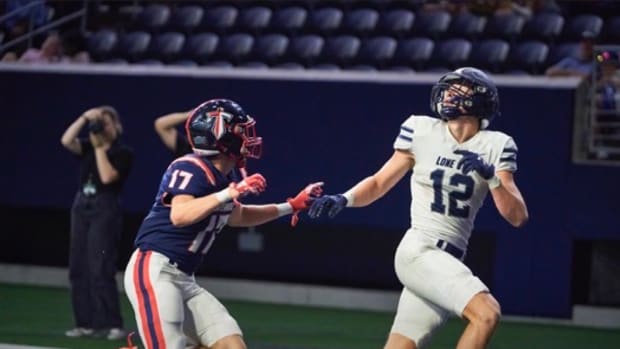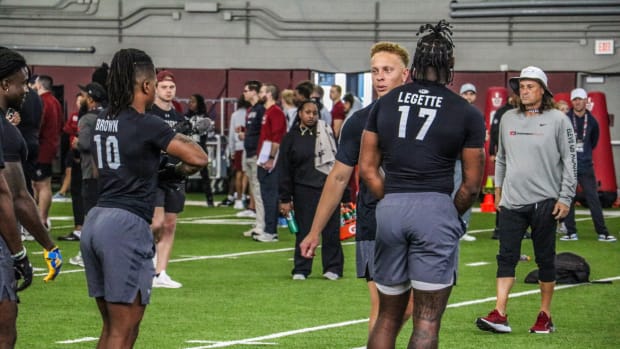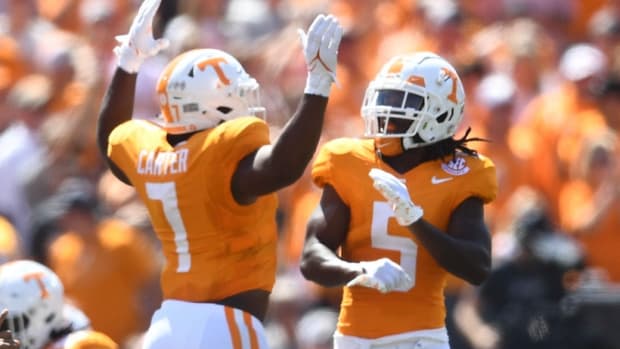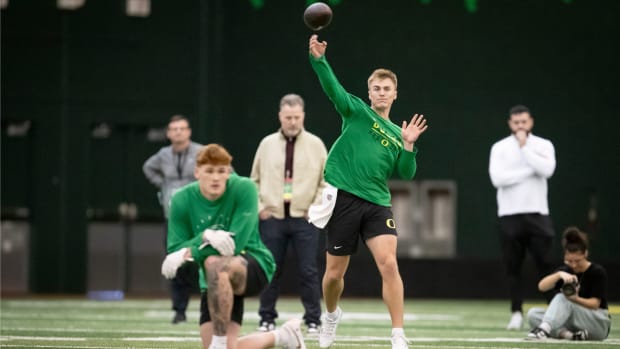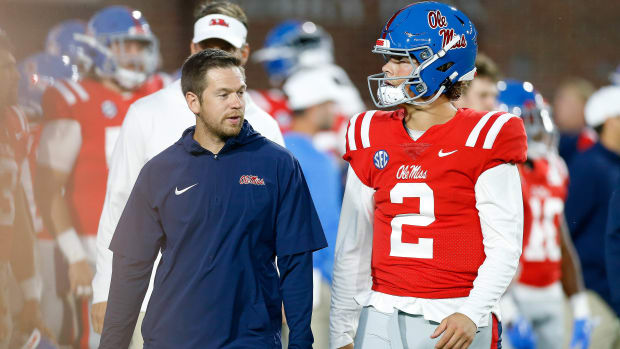What the ACC's Soft Showing in the 2019 NFL Draft Says About the Home of the National Champs
The alarm bells started ringing in the Big 12 two years ago when the combine invites got mailed. Then, when the NFL draft results started pouring in, the ringing only got louder. When the 2017 draft ended, the league had only 14 players selected—an average of 1.4 per team. That was at the bottom of the Power 5, and it was a glaring indictment of the product on the field.
The good news for the Big 12 is the athletic directors and coaches paid attention. In each of the past two years, the number of players drafted has risen. The top pick in the draft has come from the league in both years. The trend looks to stay positive for the foreseeable future.
The draft is a great indicator of the health of a league because the job security of the NFL executives who select players is tied to the quality of the players they choose. We may question some individual decisions, but in the aggregate, NFL execs don’t pick sentimentally or based on fandom or any other bias. They just try to pick the best players. So you can complain about media bias toward the SEC all you want, but the fact that the league has the most players drafted year after year means it has the deepest talent pool. Meanwhile, when the draft issues a warning—as it did to the Big 12 two years ago—a league would be wise to heed it.
The warning this year went to the ACC, which had 28 players drafted. That’s an average of two per team, which ranked fifth in the Power 5 behind the Big 12 (2.6), Pac-12 (2.75), Big Ten (2.86) and SEC (4.57). What’s especially shocking about this number is that the ACC has consistently placed second in total number of players drafted in previous years and that the ACC currently has the best team in college football. Reigning national champion Clemson did its part, getting six players drafted (including three first-rounders). Given what we’ve seen on the field, the Tigers will continue to hold up their end of the bargain. In each of the next two years, they’ll probably have more players drafted than they did this year.
During the season, the rest of the ACC felt down. The league went 6–5 during bowl season—Boston College’s game against Boise State was called because of lightning—but its 7–13 record in regular-season nonconference play was a tipoff that something was off in a conference that had worked hard to shed the underachiever label it earned in the first decade of this century. The draft numbers only reinforced that notion. Yes, the ACC was as bad as you thought it was this year.
This is the part where the Clemson ain’t played nobody people chime in. You can stop. The Tigers played two SEC teams (Texas A&M and South Carolina) in the non-conference and will do the same again this year. Clemson’s dominance of Alabama in the national title game was all we really needed to see to validate the 2018 Tigers, but I did find it funny when I went on The Paul Finebaum Show on the SEC Network last week and Paul’s first question was about Clemson’s schedule. It’s as if no one remembers Alabama getting these same questions when the SEC hit a down spell in ’15 and ’16.
But the rest of the ACC does need to do its part to help Clemson, which has built one of the best programs in the country and should compete for the national title for at least the next few years. Had Clemson lost to Syracuse—when quarterback Trevor Lawrence got knocked out of his first start and former fourth-stringer Chase Brice had to save the Tigers’ bacon—there would have been a legitimate argument about whether Clemson deserved to even make the playoff. (Plus, the Orange would have been in position to win the Atlantic Division title and shut Clemson out of the ACC championship.) In the preceding few years, a one-loss ACC champion would have seemed a lock for the playoff. But as currently constituted, the league might force its champ to go undefeated to make the playoff.
Whose fault is this?
The easy answer is to look to Tallahassee. Clemson wrested control of the league from Florida State in 2015, and the Seminoles have gone in the opposite direction. The Florida State fans who have complained that Jimbo Fisher’s recruiting slipped badly in his final years there got some serious ammunition this weekend. Only two Seminoles—first-round edge rusher Brian Burns and sixth-round defensive tackle Demarcus Christmas—were drafted. That’s equal to the number in 2016, but that year followed a three-year span in which 29 Seminoles got drafted. There is no such excuse this time. Willie Taggart, who replaced Fisher last year and promptly snapped Florida State’s streak of consecutive bowl games, must recruit and/or develop players the NFL will want. That will help Florida State win games (the Seminoles’ ultimate goal), and it will help the ACC as a whole.
Two less obvious culprits are Louisville and Virginia Tech. Neither had a player drafted, and this year was the first time in 25 years that the Hokies have been shut out of the draft. We discussed a few weeks ago what happened—or didn’t happen—in the final years of Bobby Petrino’s tenure at Louisville. The Cardinals have taken steps to correct those issues by firing Petrino and hiring Scott Satterfield, but improving the roster could take time. It’s easy to forget that following the Cardinals’ first season in the ACC, they churned out a school-record 10 picks in the 2015 draft. Petrino and his staff signed a Heisman Trophy winner (and future first-rounder) in Lamar Jackson—future first-rounder Jaire Alexander committed to Strong’s staff shortly before Strong left for Texas—but the NFL pipeline generally dried up when the Cardinals ran out of Strong-era recruits.
Virginia Tech is a little more nuanced. The first few years of Justin Fuente’s tenure looked similar to the tail end of the Frank Beamer era from a draft standpoint. (The first year looked better from a record standpoint.) Last year, the Hokies produced two first-rounders (the Edmunds brothers) and five total draft picks. Virginia Tech dealt with massive attrition last offseason, so it’s reasonable to assume that a more stable roster would have produced a draftee or two. Logic dictates that if Virginia Tech can return to its place as one of college football’s most consistent programs, the draft pipeline will reopen.
The good news for the ACC is that it appears most of the people in charge seem to have taken the steps to correct the issues exposed this season. Georgia Tech (zero draftees) is switching from the option to a scheme more conducive to producing NFL players—which should change the type of players the Yellow Jackets sign. Louisville has changed coaches. North Carolina swapped Larry Fedora for Mack Brown, and Brown’s addition of assistant Tim Brewster as an ace recruiter should help bolster the talent level. (Which wasn’t that bad; Fedora’s teams had some awful injury luck.) Meanwhile, NC State, Miami and Boston College keep producing talent.
The ACC has the best team on the field. It should cycle back up in terms of talent, too. Because it seems the schools noticed the warning signs before the draft pointed them out in stark detail.
A Random Ranking
I was struggling to come up with a topic this week, but reader @TrailRN610 came up with an excellent one.
Earlier this month, I put the Superman theme on the radio as I drove my kids to school. I mentioned that it was composed by John Williams and that Williams had scored lots of other movies including Star Wars. My nine-year-old, who had never heard of Williams, started rattling off movie themes that also were composed by Williams. Harry Potter. Jurassic Park. E.T. He didn’t know Williams at all, but he was essentially reciting Williams’s résumé because the sound is so distinctive.
Instead of entire scores, let’s stick to main themes. (Even though my favorite Williams song isn’t a main theme.) The entire catalogue is so ridiculously deep that I’m sure to miss something I shouldn’t.
1. Star Wars
2. Jaws
3. Superman
4. Jurassic Park
5. The Harry Potter Series
6. E.T.
7. Raiders of the Lost Ark
8. Schindler’s List
9. Close Encounters of the Third Kind
10. Saving Private Ryan
Three and Out
1. My editor Eric Single drew the unenviable task of writing the Way Too Early 2020 Mock Draft. Here are 32 names that are sure to change between now and 360 days from now.
2. SI’s Ross Dellenger checked in on Mike Locksley’s first spring practice at Maryland.
3. Are you interesting enough to be chosen to visit the Middle East with Washington State coach Mike Leach? Give it a shot and find out!
What’s Eating Andy?
Don’t worry. There are no spoilers from Sunday’s Game of Thrones episode here. Just something you’ll probably watch at least 10 times.
What’s Andy Eating?
The line at Prince Street Pizza wasn’t too long on a recent Wednesday. Ten, maybe 15 minutes. We were lucky, because occasionally it wraps around the block. As I waited in line with my New York food sherpa (and partner on SI’s NFL draft live show) Dan Rubenstein, Dan explained the wonder of the pepperoni cups on the Spicy Spring slice.
We’ve all seen pepperonis curl thanks to the heat of the oven. A standard pepperoni’s edges will bend skyward and then turn brittle. That perimeter will turn to dust with a touch. Dan explained that Prince Street Pizza’s pepperonis wouldn’t do that. They would still curl, but they’d retain all their physical properties. This would create dozens of little vessels that would hold tiny pools of oil. Each bite would upset some of these cups, spilling the oil onto the cheese. It would then mix with the spicy sauce and the thick, airy dough to form what might be New York’s perfect pizza bite. This is saying something, because we’re talking about a rectangular slice of Sicilian in a city of thin, floppy triangles.
“But what should I get?” the man in front of us asked Dan. “I don’t eat meat.” Dan isn’t the type to question anyone’s life choices. He guided our linemate toward the Margherita, but the look on his face told the story. We’re standing in this line for pepperoni slices. So is nearly everyone else. If you leave off the pepperoni, you lose a crucial piece of the experience.
And those pepperonis are amazing. They’re thick but not too chewy. They still snap when the canines begin their thrashing. But it turns out that while they are the most recognizable part of what has become an iconic slice, they aren’t the most important. A former Prince Street Pizza employee learned that the hard way when he defected to a place on the Upper West Side and that place began selling slices that looked almost identical to the Spicy Spring. It was a minor scandal with threats of legal action.
The crowds didn’t materialize at the new place, though. Eater critic Ryan Sutton quickly pinpointed why. While the defector had copied the pepperonis, he hadn’t copied the dough. Maybe this was intentional to prove he hadn’t stolen the recipe. Maybe he thought he could improve upon it. No matter the reason, the copycat failed because it didn’t have the same thick-but-impossibly-light body with a thin, crisp crust on the bottom. It may sound counterintuitive, but the only way to carry the weight of those pepperonis, that cheese and that gloriously spicy sauce is with something that has substantial volume but feels lighter than air. When the oil pours from the pepperoni cups, it mixes with the cheese and sauce and hides in all those little air pockets. The Spicy Spring is the Rube Goldberg machine of pizza, and all the parts must be in perfect working order to produce the desired effect.
They still are at the original shop. Hopefully they’ll never change a thing.

